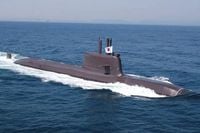In a significant move for international defense collaboration, South Korean shipbuilders Hanwha Ocean and HD Hyundai Heavy Industries (HHI) have submitted a joint proposal to Canada for a multibillion-dollar submarine procurement project. This marks the first time these rival companies have teamed up under the newly established "One Team" initiative, aimed at enhancing their competitiveness in the global defense market.
The proposal, submitted in early March 2025, outlines plans to deliver four advanced KS-III submarines to the Royal Canadian Navy by 2035, with an estimated cost ranging from $20 billion to $24 billion. This ambitious project is part of Canada’s broader Canadian Patrol Submarine Project (CPSP), which seeks to acquire eight to twelve submarines, each weighing around 3,000 tons, to modernize its naval capabilities.
As part of their commitment, Hanwha and HHI have pledged to establish submarine maintenance facilities in Canada and to hire local personnel, which is expected to create jobs and foster local expertise in submarine technology.
The Canadian Department of National Defence (DND) initiated the CPSP in July 2024, with the aim of enhancing the Royal Canadian Navy's ability to detect and deter maritime threats. The DND has emphasized the necessity of procuring up to twelve submarines to ensure the defense of Canada's three coasts. The federal government is keen to work with industry partners to find a suitable supplier that can deliver the required submarines.
Industry sources indicate that the proposal from Hanwha and HHI is a direct response to the changing dynamics of global defense procurement, particularly as Canada seeks to diversify its defense partnerships. This shift comes amid strained relations with the United States, prompting Canada to explore alternatives to traditional suppliers.
According to reports from the Canadian Broadcasting Corporation, the KS-III submarines are well-equipped to meet Canada’s operational requirements, including stealth capabilities and Arctic deployability. The submarines displace nearly 3,700 tons when submerged and can operate for up to 20 days without surfacing. They are also equipped with vertical launch systems for land-attack cruise missiles, advanced combat management systems, and modern sonar technology, positioning them as one of the most capable non-nuclear submarines available on the global market.
"These features make the KSS-III one of the most capable non-nuclear submarines on the global market," an industry expert noted, highlighting the competitive edge South Korea holds in this procurement process.
This proposal is not just a bid for a lucrative contract; it also represents a significant turning point in the relationship between Hanwha Ocean and HHI. Historically, these two companies have been fierce competitors, particularly in projects like the Korean Next-Generation Destroyer (KDDX). Their rivalry became so intense that it led to legal disputes, and experts believe it contributed to South Korea losing an $11.1 billion contract for Australia's SEA 5000 project to Germany and Japan.
The joint proposal to Canada is seen as a potential game-changer, not only for the two companies but also for South Korea's defense export ambitions. It reflects a strategic shift towards collaboration in a sector that has traditionally been marked by competition. A DAPA official remarked, "This is the first time Korean competitors in the defense industry have teamed up for an overseas bid," underscoring the significance of this partnership.
Looking ahead, the Korean shipbuilders are also eyeing opportunities in Poland, where the Orka Project is underway. This project seeks to procure three 3,000-ton submarines and is expected to be valued at around 8 trillion won. In March, the Korean side submitted an additional proposal to Poland, indicating that collaboration between Hanwha and HHI could potentially shorten delivery schedules by one to two years.
As the Canadian government moves forward with its procurement plans, it will face competition from established European defense contractors, including Germany, France, Spain, and Sweden. However, the joint proposal from Hanwha and HHI may provide Canada with a fresh alternative and a robust partnership that aligns with its strategic defense objectives.
The Canadian Patrol Submarine Project is not merely about acquiring new vessels; it is about ensuring national security and enhancing the Royal Canadian Navy's operational capabilities in a rapidly evolving geopolitical landscape. With the inclusion of local facilities and personnel in the proposal, the collaboration between South Korea and Canada could set a precedent for future defense partnerships.
As the bidding process unfolds, all eyes will be on the outcome of this significant proposal and its implications for both nations' defense strategies. The potential for a strengthened bilateral relationship through defense collaboration could pave the way for further joint ventures in the future.




